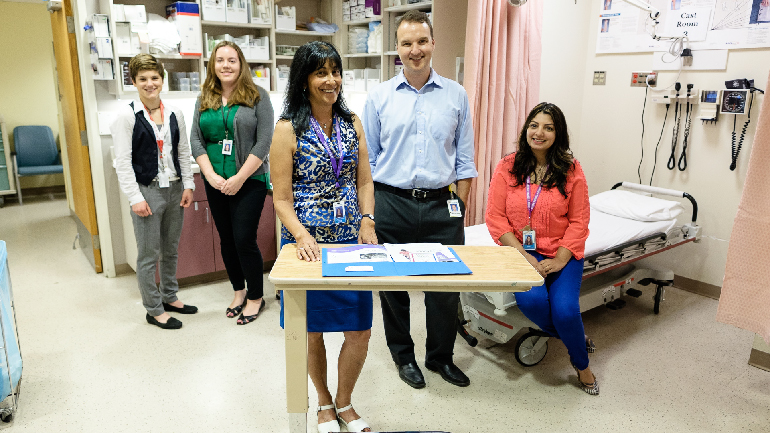
Service that helps avoid recurring bone fractures in middle aged and older patients moves from prototype to regular practice.
Osteoporosis, a condition causing bones to be more likely to break, can lead to “fragility fractures” that occur with minimal trauma such as a fall from standing height or simply the pressure of a cough or sneeze. In addition to the impact on quality of life, the financial costs are high. Looking at hip fractures alone in the Fraser Health region, over 1,200 fractures occurred in 2011/2012 at an estimated cost of $92 million.
Although osteoporosis is more common in older people, related fractures can occur in people as young as 50. Osteoporosis is more common in women, but men can develop the condition too.
In spring 2012, in an effort to reduce recurring fractures, Dr. Sonia Singh, Fraser Health’s regional program medical director for research and development, brought together a group of researchers, health care providers and patients from the health authority’s relevant programs and services - Emergency, Surgery, Older Adult, Home Health and Primary Care. Their aim was to develop a health care model that would prevent additional breaks in patients admitted to hospital with an initial fracture.
“We wanted to offer a service that would provide appropriate investigation and treatment right at the point of care,” says Dr. Singh. “Osteoporosis as a cause of fracture is rarely investigated or treated despite treatment options that can reduce the risk of new fractures by up to 50 per cent.”
While assessing what other jurisdictions across Canada and internationally were doing, the research team learned about a Fracture Liaison Model and adapted it to the B.C. health care system. Their model centres on a key role played by a coordinator who works with the orthopedic surgeons and meets with patients right in the orthopedic clinic after they’ve received initial post-fracture care. The coordinator identifies patients who show signs of osteoporosis, organizes tests, uses a risk assessment tool to assess likeliness of another fracture, and organizes the start of osteoporosis treatments if needed. The Fracture Liaison Service also includes patient education with printed handouts and a group class at a later time with a multi-disciplinary team providing information on diet, exercise, preventing falls and medication. Another important part of the service is ongoing communication with family doctors.
To get sustained funding for the service, Dr. Singh and her team needed to study a prototype of it. They received planning funding from the Canadian Institutes of Health Research (CIHR), prototype funding from the Peace Arch Hospital Foundation, and study funding from the Ministry of Health’s Active Living BC program. The study took place at Peace Arch Hospital, spanned a year and a half, and was completed in 2015. Data of a control group who didn’t participate in the Fracture Liaison Service was compared to data of the study group.
“The results were impressive,” says Dr. Singh. “For example, looking at patients who were at high risk of re-fracturing, only 22 per cent of those who didn’t access the service were appropriately treated for osteoporosis compared to 76 per cent of the patients who did access the service.”
“We took every opportunity to share our study with decision makers,” says Dr. Singh. This included presentations to the Clinical Operations Committee and leadership of the Primary Care Network. However, these were regional leaders and decisions were now often being made by the site leadership of each hospital. Once aware of that, a presentation was made to directors of Peace Arch Hospital where the study had taken place.
Members of the research team took a number of other steps to add weight to their study: From the start, they involved a patient with osteoporosis, Larry Funnell, as an integral member of the research team. “Larry has played a key role in planning and implementing the service and the study, and he regularly co-presents with me,” says Dr. Singh. “We keep connecting with people so they don’t forget.” The team held a post-study celebration, inviting hospital directors so they could hear more from patients, orthopedic surgeons and others about how the service had made a difference. The service received national certification from Osteoporosis Canada. Study results were presented in 2016 at the international Fragility Fracture Network meeting in Rome, and the researchers were invited to present at the 2017 Osteoporosis Canada National Fracture Liaison Service forum in Toronto.
With all these steps taken, the team caught the particular interest of one Peace Arch Hospital director, Teresa O’Callaghan, who took a creative approach to moving the service into regular practice: An existing but unfilled nurse practitioner position is being repurposed to include the coordinator role.
“Getting to this point has been a lot of work with about 25 people on the core team and many more helping over the past five years,” says Dr. Singh. “But the service is very successful so we look forward to seeing it continue at Peace Arch Hospital, and we hope to see it expanded across the region as soon as possible.”
Interested in getting involved in research? Contact us for more information.
